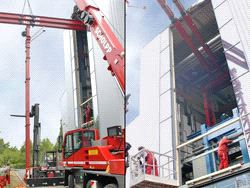Offset Printing
Second KBA Commander CT soon to go live at Main-Post

Thursday 21. August 2008 - World premiere: first eight-high wet offset newspaper press
On 27 and 28 September last year an eighteen-month test phase at the Main-Post newspaper in Würzburg, Germany, culminated in the market launch of KBAs innovative compact wet offset press, the Commander CT, under the banner “The Future is Compact”. Impressed by its performance, in February this year New Yorks Daily News awarded a contract for a fifteen-tower Commander CT 6/2 press line and a few weeks ago longstanding KBA customer Straubinger Tagblatt in Bavaria also placed an order.
Spanish newspaper publishing house Heraldo de Aragón in Saragossa did not even wait for completion of the test phase before signing up for a Commander CT with a web width of 1,640mm (64.5in). The press, which went live two months ago, compellingly confirmed the benefits of the compact design demonstrated in Würzburg: minimised fan-out (comparable to a satellite press), a big drop in production waste, a superior print quality and user-friendly operation.
Fourth premiere in just twelve months
The Main-Post has since celebrated two more premieres, both implemented on the Commander CT with the aim of stimulating ad sales: ZipnBuy (a sidebar and coupon perforator) and Natural Print (where the title page was printed on recycled packing paper). Now, continuing its innovation drive, the Main-Post media group is preparing for yet another premiere following the challenging placement in July by KBA fitters and Stuttgart specialist Scholpp Montage of a second 58-tonne Commander CT tower atop the existing one. This, the worlds first eight-high conventional press, has enabled production capacity to be substantially increased in a minimum of space, without the considerable expense of extending the press hall and without disrupting the daily production routine. Commissioning is scheduled for September. With two reelstands the 9m (29ft 6in) high press line will be able to print 32 full-colour broadsheet pages or 64 tabloid pages.
Innovative compact platform offers many benefits
The only other eight-high tower press in operation is a waterless Cortina which went live at Edipresse in Lausanne, Switzerland, a good two years ago. The Commander CT and Cortina are the only presses on the market that support such space-saving sixteen-couple configurations. KBA started pioneering its highly automated compact platform (which includes fully automatic plate changing) eight years ago, initially in the shape of the waterless Cortina. KBA believes that flexibility and automation are crucial in enabling the newspaper industry to meet the challenges presented by electronic media. While other manufacturers have since adopted different approaches, these cannot compare with the fundamental technical, economic and ergonomic advantages of KBAs ultra-compact design. The blanket-to-blanket Commander CT is superior to satellite presses in its ease of operation and maintenance, its energy consumption and when printing both improved newsprint and heatset semi-commercials. And since the dreaded fan-out associated with conventionally built four-high towers is no longer an issue, KBA even offers a triple-wide version of the Commander CT, with a web width of 2,100mm (82.75in).
Winning over satellite fans to compact technology
The new-design film inking units on the KBA Commander CT have three forme rollers, which reduce ink mist and thus promote an optimum print quality, even in problematical images and on troublesome substrates. RollerTronic automatic roller locks and innovative NipTronic bearing technology – a combination unique to the Cortina and Commander CT – also enhance quality while reducing manual input. No wonder two former satellite fans, Main-Post technical manager Andreas Kunzemann and printshop manager Adrian Alt-Steiner, have become converts to compact technology.
